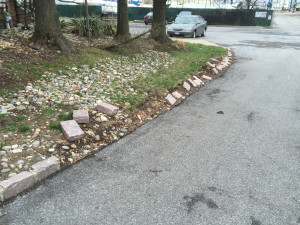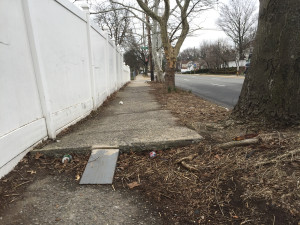NJ Infrastructure Maintenance – Who’s Responsible?, Immune?, Liable?
Annual NJ Infrastructure Maintenance Demands
As the snow melts, and we enter spring, it’s likely that Municipal Engineers will discover an array of problems to fix, within the boundaries of public streets – from huge potholes – to curbs, broken by errant snowplows – to cracked, spalled or heaved sidewalks. How do we prioritize the repairs and sort out who is responsible for making them? Undoubtedly, we want to correct the problems before someone gets hurt and the municipality we work for is sued.
Public Entity Immunity
Infrastructure maintenance including pavements, drainage systems, curbs and sidewalks in public streets is an ongoing challenge for municipal engineers who are attempting to stretch their transportation funding while avoiding costly litigation. When an individual is injured within a New Jersey public right-of-way, The New Jersey Tort Claims Act, N.J.S.A. 59: 1-1 et seq., provides some immunity to local governments – that immunity is not absolute.
New Jersey Statutes 59:2-1 provides the following general immunity for public entities:
A public entity is not liable for the exercise of discretion when, in the face of competing demands, it determines whether and how to utilize or apply existing resources, including those allocated for equipment, facilities and personnel unless a court concludes that the determination of the public entity was palpably unreasonable. Nothing in this section shall exonerate a public entity for negligence arising out of acts or omissions of its employees in carrying out their ministerial functions.
Public Entity Liability
Note that N.J.S.A. 59:2-1 requires that the entity make a determination about the allocation of limited resources and that the determination was not “palpably unreasonable”. In other words, obviously unwise, plainly absurd or patently foolish. What about a complete failure to act? Does a municipal entity have an obligation to understand what the competing demands for resources are – before allocating limited funding? I think, that a good argument could be made, that it does.
Also note that immunity is not provided to a public entity for negligence arising out of the performance of “ministerial duties” – functions that demand no judgment or discretion. Is filling a pothole a ministerial function? How about replacing a missing stop sign or manhole cover? What about repairing a broken sidewalk or curb?
New Jersey Statutes 59:4-2 establishes general public entity liability, as follows:
A public entity is liable for injury caused by a condition of its property if the plaintiff establishes that the property was in dangerous condition at the time of the injury, that the injury was proximately caused by the dangerous condition, that the dangerous condition created a reasonably foreseeable risk of the kind of injury which was incurred, and that either:
- a negligent or wrongful act or omission of an employee of the public entity within the scope of his employment created the dangerous condition; or
- a public entity had actual or constructive notice of the dangerous condition under section 59:4-3 a sufficient time prior to the injury to have taken measures to protect against the dangerous condition.
Nothing in this section shall be construed to impose liability upon a public entity for a dangerous condition of its public property if the action the entity took to protect against the condition or the failure to take such action was not palpably unreasonable.
So, the public entity can be liable, not only if had notice of a dangerous situation – but also if it had constructive notice of the dangerous condition. A public entity will be deemed to have constructive notice “if it had actual knowledge of the existence of the condition and knew or should have known of its dangerous character.” Thus a plaintiff simply needs to establish “that the condition had existed for such a period of time and was of such an obvious nature that the public entity, in the exercise of due care, should have discovered the condition and its dangerous character.”
Maintaining Immunity
So — how can municipalities behave to protect against the loss of protection provided by the Tort Claims Act?
Certainly, it’s far better to minimize the potential for accidents by maintaining curbs, sidewalks, pavements, drainage systems, traffic control systems and other facilities in good condition. Unfortunately, given budget constraint, this goal is seldom achievable. Therefore, it’s important to:
- First – define the municipal responsibility for infrastructure maintenance;
- Next, – develop a method to prioritize the order of work.
Determining Responsibility
When considering who is responsible to maintain infrastructure within the public right of way, a few questions immediately come to mind.
- Whose right-of-way is it? – State? – County? – Municipal? – Other?
- What are the limits of jurisdiction at intersections?
- What part of the roadway is it?
- Pavement
- Curb
- Sidewalk
- Curb ramp
- Traffic Control Device
- Utility and Street Hardware
- Does the abutting property owner have a responsibility?
- Curb installation or repair
- Sidewalk installation or repair
- Wheelchair ramp installation or repair
- Driveway apron installation or repair
- Who has an obligation to inspect for hazards?
- State?, County?, Municipality?, Property Owner?, Utility Company?, Other?
- If a municipal responsibility, who is charged with making the inspections?:
- Municipal Engineer
- Code Enforcement Official
- Public Works Director
- Police Department
- Other
- What standard is used to determine if a defect is hazardous?
- Who determines if, and when, an observed defect should be fixed?
- How is maintenance funded?
- Annual Operating Budget
- Capital Budgets and bonding
- Grants
- Property Owner Assessments
- Other Private Sources
I hope to explore these matters in more detail in future articles. Please provide me with your comments or suggestions about how to address these and other municipal engineering, code enforcement and alternative dispute resolution issues.
The author, Carl E. Peters is one of fewer than 10 people licensed by the State of New Jersey as a Professional Engineer, Professional Land Surveyor, Professional Planner, Construction Official, Building Subcode Official and Plumbing Subcode Official. He is also a Certified Municipal Engineer and Mediator and founder of Carl E. Peters, LLC




 D5 Creation
D5 Creation